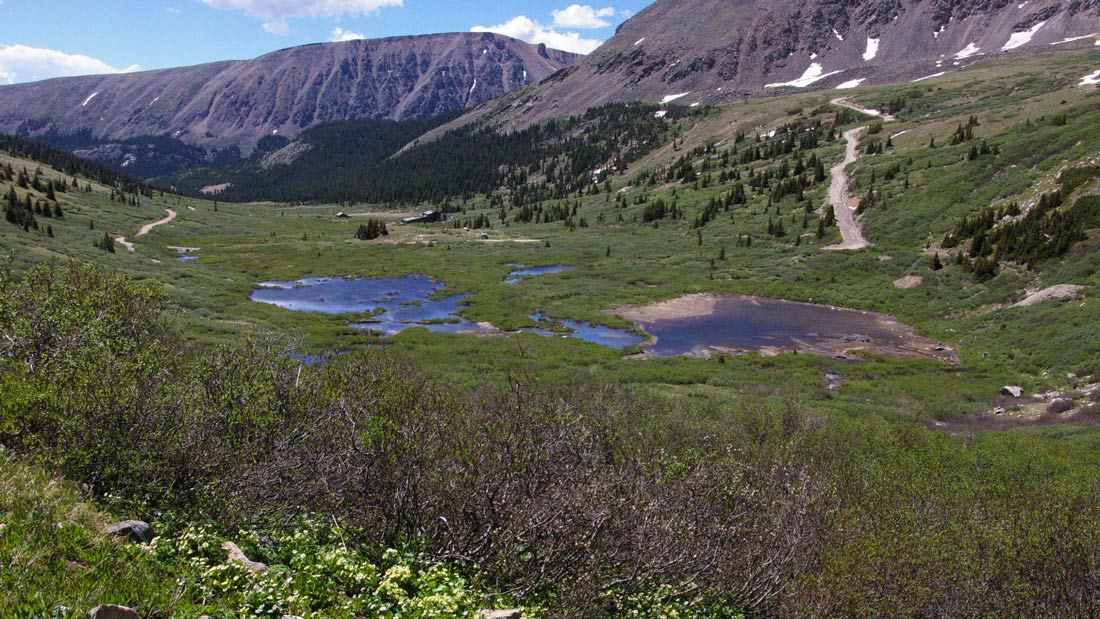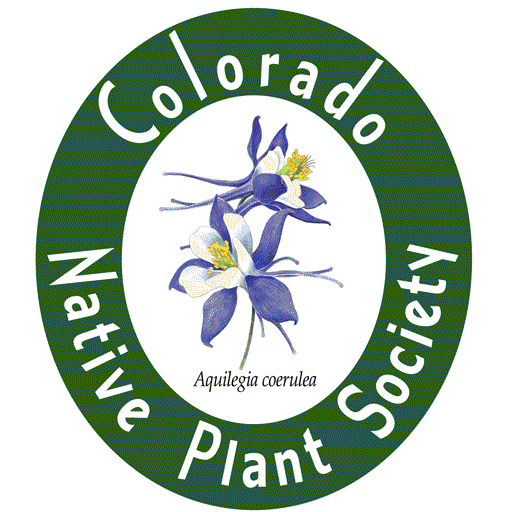Subalpine Willow Carrs
Mosquito Pass, Mosquito Range
In our Colorado Rocky Mountains, willow carrs are riparian shrublands that occur as narrow bands or broad shrublands in montane altitudes (8,000–10,000’) and into the upper reaches of subalpine areas (11,500’). Willows prefer full sun and soils that are saturated throughout the growing season. That is why they are so prevalent in montane and subalpine meadows along streams and where water, primarily from snowmelt, collects on alluvial benches. Because of their ability to reproduce vegetatively, they generally form dense stands. They grow in low-gradient valley bottoms with sinuous stream channels as is shown in the middle ground of the photo above, as well as in steep moist avalanche chutes. The shrubs are from 1½ to 5 feet tall depending on their altitude and exposure.
In the photo above, which was taken in Mosquito Pass in the Mosquito Range, northwest of Alma in South Park, you can see a narrow band of willows in the foreground which follow Mosquito Creek. This creek drains from a large basin below a ring of peaks. In this area as well as most other willow carrs, moisture comes primarily from snowmelt that runs down slopes in tiny rivulets to small creeks and feeds the willows throughout the summer growing season. Willow carrs may also be found around seeps, fens, and isolated springs away from valley bottoms and in ponds formed created by beaver activity.
There are several types of riparian shrublands in montane altitudes (8,000 – 10,000′). One is dominated by Speckled Alder (Alnus incana) with a variety of shrubs that are subdominant, include Water Birch (Betula occidentalis), Mountain Willow (Salix monticola) and Drummond’s Willow (Salix drummondiana). Bebb’s Willow (Salix bebbiana) and Booth’s Willow (Salix boothii) also can be the dominant shrub in the montane willow carrs.
However, when one gets into the subalpine, over 10,000 feet, all riparian shrub communities are dominated by one of four species of willow, Mountain Willow (S. monticola), Plain-leaf Willow (S. planifolia), Wolf’s Willow (S. wolfii var. wolfii) and Short-fruit Willow (S. brachycarpa).
Mountain Willow (Salix monticola) appears primarily in the montane zone starting at 8,300 feet. But it creeps into the lower subalpine up to 10,240 feet where its herbaceous understory is dominated by beaked sedge (Carex utriculata), grasses such as Tufted Hairgrass (Deschampsia caespitosa) and Bluejoint Grass (Calamagrostis canadensis). Some other sedges, such as, water sedge (Carex aquatilis) may also be present. Natureserve calls this plant community the Salix monticola / Carex utriculata Wet Shrubland. It grows along wet banks and terraces of low-gradient, subalpine streams in broad valley bottoms, and is often found near beaver ponds. Although the herb understory is dominated by sedges and grasses, a few forbs such as Heartleaf Bittercress (Cardamine cordifolia), Streamside Bluebells (Mertensia ciliata), and Cow Parsnip (Heracleum maximum) may also be found there.
Some Indicator Plants
Click on photo to see full-page lightbox image.
In lightbox, click on X in upper right corner to return here.
Tufted Hairgrass (Deschampsia caespitosa)
Tufted Hairgrass (Deschampsia caespitosa) is one of the species of grass that grows in the "Salix monticola / Carex utriculata Wet Shrubland" plant community in subalpine willow carrs. It is native and also common in moist meadows, moist alpine, along lake margins, and in wetlands from plains to alpine on the eastern and western slopes. Blooms from July through September. Photo by Mo Ewing
The second willow carr described by Natureserve is the “Salix planifolia / Calamagrostis canadensis Wet Shrubland. It occurs at higher altitudes from 8,960-11,475 feet. It usually grows in saturated, and usually organic soils, in broad glacial valleys where its moisture comes primarily from snowmelt throughout the growing season. Shortfruit Willow (Salix brachycarpa) and Wolf’s Willow (Salix wolfii) can also be present in the shrub layer but Plainleaf Willow (Salix planifolia) is the dominant (indicator) species. In the understory, Bluejoint Grass (Calamagrostis canadensis) is the dominant species. The herbaceous layer is dense and can be species rich, but usually covers less than 10% of the ground. It can include other species of sedges such as Beaked Sedge Carex utriculata). Forb species such as Marsh Marigold (Caltha leptosepala), Heartleaf Bittercress (Caradmine cordifolia), and Elephant’s Head (Pedicularis groenlandica) are also common there.
The third willow carr described by NatureServe is the Salix wolfii / Carex utriculata Wet Shrubland. This willow carr grows mostly in the montane from 7,600 to 10,000 feet, but also climbs 700 feet into the subalpine to 10,700’ feet. It grows in low-gradient valleys on very wet broad meadows, wet alluvial terraces, and large seeps. It almost never is found adjacent to rapidly flowing water. The shrubs in this plant community are of low stature, less than 1.5 meters tall, and may include other willow species such as Salix planifolia, Booth’s Willow (Salix boothii) and Geyer’s Willow (Salix geyeriana). It also also may include other shrubs such as Dwarf Birch (Betula glandulosa), and Shrubby Cinquefoil (Potentilla fruticosa). The herbal understory is dominated by Beaked Sedge (Carex utriculata) and often has other graminoids, like Carex aquatilis, Carex microptera, Carex limosa and Deschampsia caespitosa. Like the Salix planifolia willow carr it has only a small number of herbs. These may include Pedicularis groenlandica and Caltha leptosepala, as well as Alpine Leafy Aster (Symphyotrichum foliaceum var. apricum), and Feltwort (Swertia perennis).
The last willow carr to be described here is the Salix brachycarpa Mesic Forbs Wet Shrubland, which is found from 8,500 to 11,760′. This plant community occurs along the drier periphery of broad, glaciated basins and along first- and second-order streams in the subalpine zone. (first-order streams are headwater channels with no upper tributaries; second order streams have two upper tributaries) The stream channels vary from wide and shallow to narrow, deep and sinuous. Sites can be gentle to steep, and they can be well-drained mesic slopes or elevated hummocks above wetter areas. Other Salix species may also be present but are sub-dominant. This willow carr has a rich and diverse forb community which includes all of the species in the willow carrs described above, as well as many more such as Mountain Strawberry (Fragaria virginiana), Arrowleaf Ragwort (Senecio triangularis) and Alpine Meadowrue (Thalictrum alpinum).
References
Western Montane-Subalpine Riparian & Seep Shrubland, NatureServe Explorer
Salix planifolia / Calamagrostis canadensis Wet Shrubland, NatureServe Explorer
Salix wolfii / Carex utriculata Wet Shrubland, Natureserve Explorer
Salix brachycarpa mesic forbes shrubland, Natureserve

